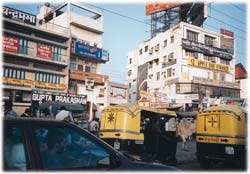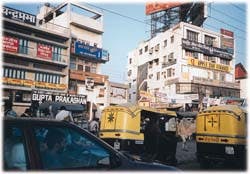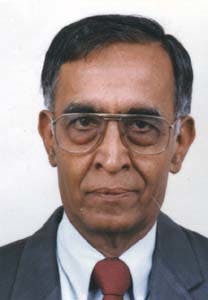India Needs Power-Plant Feedstock, Petrochemicals, And Lubes In Its Refineries
R. Krishnamurthy
Consultant
New Delhi
The frenetic traffic of the streets of New Delhi is dominated by diesel-burning, three-wheel taxis (with yellow cabs) that spew out heavy exhaust. This mix of vehicles and their fuels has put its print on Indian refining schemes.Indian refineries can increase returns on investment by using refinery bottoms for power production (for which there is a considerable shortage in India), by diversifying into petrochemicals (like benzene and mixed xylenes), and by producing lube basestocks.
The conventional Indian refinery must be modified to achieve these diverse products, to make higher profits, and to meet future environmental restrictions.
The following proposed modification of the conventional Indian flow scheme is based on average 1993-95 prices. The new scheme will meet future quality requirements without the production of surplus gasoline.
Power production is a good outlet for high-sulfur vacuum residue. The use of residue avoids pollution problems because the power plant uses a flue-gas desulfurization (FGD) unit. It also reduces the requirement of distillate-material cutter stock. Power production in this way increases the Indian refinery's profitability.
The capacity utilization of most Indian refineries is about 100%. Build-up of capacity has followed the demand of petroleum products over the past several years. The 1996-97 Indian consumption of petroleum products was 79 million metric tons/year (mty). The crude-refining capacity is about 62 million mty. With the commissioning of projects under construction, capacity will be about 70 million mty within a year.
Two more refineries under construction will add 20-25 million mty to refining capacity. Assuming a conservative growth rate of 5%/year (for the past 2 years the annual increase has been 9-10%), the demand is likely to be 122 million mty by 2005.
Historical margins
Since the 1973 oil crisis, in countries with a free market economy, refinery margins have been squeezed as a result of overcapacity.A large number of refineries were built during the 1960s and 1970s. In some countries, the refining products were exclusively for export. In many places, simple hydroskimming refineries (without conversion processes like catalytic cracking and hydrocracking) were installed. After oil prices increased, these refineries were not even able to meet the cash costs.
Secondary processing units, like catalytic crackers and hydrocrackers, were installed in the late 1970s and the 1980s (particularly in Europe) to make refining more profitable. During most of the 1980s, the cash margins (without depreciation and financing charges) available in U.S. Gulf Coast refineries were below $1/bbl (OGJ, Oct. 28, 1996, p. 80).
The situation is more hopeful in India than in the U.S. and Western Europe. Indian margins are better as a result of lower operational costs and better crude-product differentials (based on import-parity prices). Conventional refining in India, however, will still give a poor-to-moderate return on investment because of high interest rates.
Indian FCC choice
To increase distillate production in the 1980s, many Indian refineries increased capacities and added conversion capacities for vacuum-gas oil (VGO). Two options were available to upgrade VGO into lighter fractions: fluid catalytic cracking (FCC) and hydrocracking. FCC primarily maximized gasoline, which fit ideally with U.S. demand. Hydrocracking, on the other hand, fit with Indian demand because it maximized middle distillates.Although the hydrocracker was more ideal, the FCC route was chosen in all Indian refineries to upgrade VGO to middle distillate because of the lower investment cost. Investments in a hydrogen plant and a hydrocracker were at least 2-3 times higher than that in an FCC unit. Furthermore, FCC licensors promised a maximization of light-cycle oil (LCO), which is a diesel component, and a diesel quantity along with LPG to be about 60-70% of VGO feed.
Environmental scenario
Environmental pressure on the quality of transport fuel in the early 1980s was small except for the worldwide phaseout of lead in motor gasoline.Environmental regulations changed rapidly during the 1990s.
One of the major areas of regulation has been the sulfur content in transportation fuels, such as motor gasoline and diesel. Since 1980,
India's maximum sulfur content in gasoline has been 2,000 ppm. Developed countries initially set the maximum permissible sulfur content to 500 ppm. Regulations in California and some North European countries are as low as 40 ppm. India has not yet reduced the sulfur limit to that extent.
Per the revised BIS (Bureau of Indian Standards) specifications of 1995, the maximum sulfur content in diesel should be reduced from 5,000 ppm in 1998 to 2,500 ppm in the year 2000. Since 1993, U.S. regulations have mandated diesel sulfur contents below 500 ppm (OGJ, Sept. 16, 1996, p. 47).
Besides sulfur, developed countries also have strict aromatics regulations for gasoline and diesel. Gasoline benzene content should be below 1%. Currently, the U.S. and many major European countries restrict aromatics content to a maximum of 25% for gasoline and diesel. In fact, 98-octane gasoline was withdrawn by some U.K. marketers because of its aromatics content (OGJ, Sept. 16, 1996, p. 47).
California March 1996 standards reduced the gasoline maximum olefins contents to 6.0 vol % and lowered the maximum allowable Rvp. The lowered Rvp reduces the amount of butane that refiners can add to increase octane. These standards reduce the 90% distillation temperature to 149° C., which results in a rejection of the heavy ends of gasoline.
For diesel, besides sulfur content, there are three other factors to be considered: cetane number, aromatics contents, and 90% boiling point. In most Western European countries, the cetane number is more than 50. In fact, European automobile manufacturers insist on a cetane number higher than 50 for low-emission fuels (OGJ, Jan. 25, 1993, p. 29) although many countries allow refineries to produce 45 cetane number diesel. A survey by Associated Octel Co. Ltd., Milton Keynes, U.K., reveals average diesel-cetane number to be 54 for the U.K. (OGJ, Sept. 16, 1996, p. 47). Indian specifications currently require only a 45 cetane number.
India has difficulties adopting limits on aromatics contents like that of developed countries. California standards currently limit the maximum aromatics content in diesel to 10%. While this can be achieved with a blended straight-run diesel and hydrocracked diesel in some crudes, it is difficult to achieve if diesel components are from FCC LCO and coker gas oil (even after mild hydrotreatment).
Most Indian diesel contains 20-30% of untreated LCO. Large hydrodesulfurization (HDS) units, which are likely to be built by 2000, will improve the diesel quality (from 10,000 wt ppm sulfur content to 2,500 wt ppm sulfur content) and perform mild hydrogenation to saturate the olefins in the LCO. Without deep hydrogenation, however, Indian diesel will still have lower cetane numbers and higher aromatics contents than Europe's standards.
If the 90% cut point of diesel were reduced to below 350° C., there would be a further reduction in availability of diesel. This reduction, however, could be overcome by increased secondary-processing capacity.
Tables 1 [46,569 bytes] and 2 (72,016 bytes) give the gasoline and diesel specifications1 used in some of the developed countries and India.
In the 1980s, India primarily allowed only the use of coal for power generation because use of imported fuel oil violated policies supporting self-sufficiency. While this was perfectly justified for power plants near coal mines, transporting coal over long distances by rail was expensive. This policy has been relaxed in the 1990s.
India permits the use of refinery fuel oil produced from vacuum bottoms and some specification fuel oil to have as high a sulfur content as 4.5%. In Japan and Italy, fuel oil with more than 1% sulfur will not be permitted beyond 2000.
Indian refineries have chosen not to produce products of the stringent specification currently required in developed countries. Even new refineries are designed per current Indian specifications.
Conventional refinery flow scheme
Fig. 1 (110,907 bytes)shows a detailed scheme of a conventional Indian refinery. This flow scheme is similar to schemes developed over the years in Indian refineries. It maximizes gasoline production for the refinery. The scheme consists of a crude distillation unit, a vacuum unit, a catalytic reforming unit, a once-through hydrocracker for the VGO, and a visbreaker.Rather than recycling through the hydrocracker, portions heavier than diesel from the once-through hydrocracker are sent to the FCC unit. There is also an isomerization unit to maximize gasoline production. The product yield for this conventional refinery, assumed to have a 9 million mty capacity, is shown in Table 3 (18,154 bytes) . No futuristic specifications for diesel are considered in this scheme.
A large amount of gasoline is envisaged for export because the domestic gasoline demand is only 6-8%. Gas and fuel oil generated in the refinery are used as internal fuel oil. To meet export gasoline specifications, however, the refinery would need units like alkylation to reduce the aromatics content in the gasoline blend.
New refinery-flow scheme
Fig. 2 (122,446 bytes)shows a scheme developed for a new 9 million mty refinery when minimizing gasoline is desired, and Fig. 3 (132,332 bytes) shows a proposed scheme to meet increased gasoline demand.The low-gasoline scheme (Fig. 2 ) essentially consists of a crude distillation unit, a vacuum unit, a catalytic reforming unit, a hydrocracker, a diesel-HDS unit, and a lube-oil production unit. The reforming unit maximizes aromatics by recycling heavy paraffins in the reformer after extraction. Mixed-xylene and C9 aromatics are produced from the reformer. The C7 cut is extracted for aromatics to produce benzene and toluene, and the raffinate goes to a splitter. The heavier raffinate is returned to the reformer. This scheme results in the production of 17% benzene, 27% toluene, 28% xylene, and 9% C9 aromatics.2
The raffinate, along with the light straight-run cut, is sent to the isomerization unit. Kerosine is treated in the Merox unit to meet specifications. Desulfurized diesel will be blended with diesel from a hydrocracker. This blend is likely to meet even the 10% aromatics standard required in the future. A lower endpoint and a lower 90% cut point for diesel are envisaged by cutting the diesel at a lower temperature in the crude unit. The cetane number of this blend is likely more than 50.
The gasoline is a blend of isomerized product, toluene, and hydro cracker-light naphtha. Although the aromatic specification may not be strictly met, it can be improved by adding MTBE from external sources. The basic feature of this configuration is that the vacuum bottoms, instead of being processed in the visbreaker to produce fuel oil with 4.5 wt % sulfur (after adding cutter stock to meet viscosity specifications) is being used in a power plant.
Part of the hydrocracker bottom is used in the Isodewaxing unit,3 a recent technology offered by Chevron Research & Technology Co. that produces high-quality automotive lubricating oils. The product yield for the above flow scheme is shown in Table 4(30,885 bytes).
If more gasoline is required, however, the flow scheme can be revised to include an FCC unit using the bottoms of the once-through hydrocracker as feedstock Fig. 3 (132,332 bytes) . Even in this scheme, vacuum residue goes to the power plant. In both of the new schemes, low-sulfur waxy-residue (LSWR) fuel oil is imported for use as internal fuel oil to meet environmental requirements.
Profit
The cash margins for the three refineries were calculated assuming that most products are imported from Singapore and the crude and product prices are based on import parity prices for crude and products. A freight rate of $6/ton is assumed for crude in a 140,000-ton tanker traveling from the Middle East to the Indian East Coast. A freight rate of $6/ton is assumed for product in a 50,000-ton vessel traveling from Singapore to the Indian East Coast. The price of vacuum residue is the cost of the low-sulfur fuel oil minus the facility costs of FGD.Table 5 (55,616 bytes) and Table 6 list the operating costs of an FGD power plant. Based on the total recovery cost of an FGD unit, an FGD operation costs $20/ton of fuel oil. The power plant, based on available vacuum residue, can operate up to 1,300 mw. The economics of the refinery are separated from the power plant. The refineries will supply fuel to the power plant at a negotiated price.
Assuming a processing cost of $6/ton of crude ($4-6/ton is the operating cost of many Indian refineries with no purchased utilities), the cash margins for the proposed aromatics, lube oil, and power plant scheme are about $39.5/ton.
There is no difference in the investment and the cash margin between the low-gasoline and the high-gasoline processes. The investment for the conventional scheme is $1.56 billion and that for the proposed scheme is $1.65 billion, excluding port and pipeline facilities and issue expenses for shares and debentures. Based on the equity of the project, the internal rate of return (IRR) before taxes is 8.8% for the conventional scheme and 19.7% for the proposed scheme (Table 7 [56,663 bytes]).
Refineries should be flexible enough to produce more profitable products than transportation fuels. The refinery can produce mixed xylenes and benzene without a major additional investment. The prices of benzene and mixed xylenes vary widely, depending on the market. Low prices of $300 for benzene and $250 for mixed-xylenes are assumed in this study. Even with these low prices, the project looks attractive. If the prices of benzene and xylene increase, the profit margin could be higher.
Isodewaxing3 offers a good opportunity for plants with hydrocrackers to use the bottoms for producing high-quality lube basestocks for making multigrade automotive oils.
A visbreaker or coker is added in refineries to either make fuel oil or convert vacuum bottoms to higher-valued, lighter product. With the visbreaker, the refiner must add cutter stock of distillates to reduce the viscosity of visbreaker fuel oil to 380 cSt, which results in a low-quality fuel oil with a high-sulfur content. Sending vacuum bottoms straight to the power plant avoids such addition.
Tables 5 and 6 show that the cost of fuel oil in an FGD plant (downstream of the power plant) is about $20/ton. This is close to the price differential between low sulfur and 3.5%-sulfur fuel oil in the world market.
The Indian requirement of power is very huge, nearly 30,000-40,000 mw over 5 years. Even with refinery-based power production, five new 9 million mty refineries (using all the vacuum bottoms) will create only 6,500 mw of the required 30,000-40,000 mw.
Fuel-oil use
Table 8 (62,593 bytes) gives the costs of various fuels for a power plant. The cost of power-plant fuel supplied by a refinery per kw-hr power is competitive with other liquid and gaseous fuels. In the case of imported-coal fuel, the high investment for a power plant more than compensates for the lower fuel cost.Use of other liquid fuels is dependent on their market demands in the transportation sector (gasoline, diesel) and in the petrochemical sector (naphtha). The prices of these fuels are therefore likely to vary widely based on demand from competitive sources. It may not be advisable to depend on such fuels for a power plant.
On the other hand, the major use for fuel oil will be for power and industry. With sulfur specifications for fuel oil becoming more stringent (less than 1%), the high-sulfur fuel may not be allowed to be used in the future for industrial users without FGD. FGD will not be economical without large consumers like power plant.
Looking further at the world scenario, the demand of fuel oil is about 20%. For most crudes, any attempt to further reduce the fuel-oil production in the refinery requires processing more vacuum residue to lighter products. The visbreaker option leads to a low-value fuel oil after adding valuable cutter stock such as kerosine and diesel.
The coker option produces nearly 30% high-sulfur coke (which is very difficult to dispose) with nearly 10% gas. Naphtha, diesel, and VGO have to be severely hydrotreated to upgrade them to distillate fuel or to hydrocracker or FCC feedstock. Although this option is attractive in the U.S., where fuel-oil demand4 is only about 5% of total petroleum products, in other parts of the world, particularly in Asia, it is not preferable as the demand for fuel oil is more than 20%. Also, this route may not be justified because of the poor quality of products. Desulfurization of vacuum residue is a high-investment/ low-return project.
Thus, the most attractive option for vacuum residue is power production, particularly in India, where there is a huge unsatisfied demand. In addition to refining and petrochemical products, all Indian refineries should produce power, using FGD to meet future environmental standards.
References
- Hibbs, F.H., and Keesom, W.H., "The impact of product specification on oil refining," Proceedings from the UOP Refining Technology Conference, 1995.
- Isdorf, N.G., Furtaro, A.P, et al., "Platforming for Aromatics Production," Proceedings from the UOP Petrochemical Technology Conference, 1992.
- Qureshi, Wagon, Howell, Lany, et al., "Isodewaxing-improving refining economics," Petroleum Quarterly Technology, summer 1996, pp. 17-23.
- B.P.-Statistical review of world energy, p. 12.
The Author
R. Krishnamurthy is an independent consultant to the gas, petroleum, and petrochemical industries as well as to the World Bank, the Asian Development Bank, and other Indian banks.Previously, he held positions in process design and engineering at the Indian Institute of Petroleum (IIP) and at Engineers India (EIL). He retired as an EIL technical director in 1991. While he was at IIP and EIL, he was involved in planning and designing for all of the refineries in India and was a member of several government committees for policy issues on oil, gas, and petrochemicals.
Krishnamurthy holds a bachelors in chemical engineering degree from Annamalai University in India. He also holds a masters and a PhD from the Indian Institute of Technology, Kharagpur. After 3 years of teaching at the Indian Institute of Technology, Bombay, Krishnamurthy was a post-doctoral fellow in the University of Toronto for 1 year and Rutgers University for another year.
Copyright 1998 Oil & Gas Journal. All Rights Reserved.


